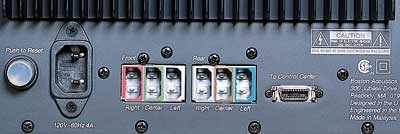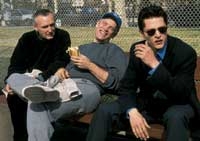Boston Acoustics Avidea 770 Home Entertainment System Page 2
Instead of the usual five satellites, Boston Acoustics provides six. They're identical except that the horizontal center speaker is slightly larger because its drivers are arrayed for more uniform dispersion. Each small but hefty cabinet is made of extruded aluminum and has two keyhole mounts plus a threaded insert for use with an optional wall bracket or floor stand. The center speaker's threaded insert fits a mounting foot that lets you tilt the speaker toward your listening position.
The subwoofer, whose wooden cabinet matches the styling of the satellites, has a 10- inch front-firing driver and dual down-firing ports. Because this is an integrated system, the subwoofer is optimized to work with the satellites. There are no crossover controls and no power rating is specified. The system amplifiers are housed in the sub cabinet, but all settings, including subwoofer level, are adjusted via the control center.
INSTALLATION AND SETUP If setting up a home theater system has ever made you curse out loud, the Avidea system will keep your language G-rated. You connect the control center to the subwoofer via a single 16-foot umbilical cable and plug the six satellites into the subwoofer using supplied cables with special, color-coded connectors. Most audio and video connectors are on the rear panel of the control center, neatly grouped by source. Setup doesn't get any easier than this. And to keep the faceplate ultraclean, Boston put a set of A/V convenience inputs and a headphone jack on the right side of the control center - not a problem because its width is 1 1/2 inches shy of the usual 17 inches. 
Hookup to your TV is also extremely simple because the control center's UniView video conversion/switching system can upconvert all video inputs to component video. That lets you use a single set of component-video cables between the control center and your TV without having to worry about switching inputs on the TV to watch different sources. An additional component-video input, which can be associated with any audio signal path, bypasses UniView so the native format from an external source (like an HDTV tuner) is preserved through to the display. 
|
Overall, the satellites provided a very articulated, upfront sound. In Chapter 8, a guitar-and-synth-driven rock & roll groove punctuates the action. The percussion was clear and snappy with lots of oomph.
Video looked good through the component-video output. Chapter 10 of Knockaround Guys takes place in a dimly lit country bar. There was plenty of detail even amid the dark hues, and the flashes of brightly colored light from the jukebox didn't smear or oversaturate. In Chapter 15, I could easily discern the details of a wanted poster as it emerged from the sheriff's fax machine.
MUSIC PERFORMANCE I loaded in Porcupine Tree's In Absentia on DVD-Audio and cued up the surround mix. In "Trains," which opens with acoustic guitar and vocals, I could clearly hear the acoustic space surrounding the guitar as well as the breathing and inflections of the singer. When electric guitars and drums kicked in, the mix thickened, but no details were lost, and the snare drum's snap was hard hitting. At extreme volumes, the sound quality became somewhat compressed and tight - lacking the warmth of softer levels - and the subwoofer couldn't quite keep up. The system can play loud, but don't expect lease-breaking volumes without some sacrifice in sound quality.
The Bottom LineThe performance of the Boston Acoustics Avidea 770 system is impressive - especially the sound quality of the tiny satellite speakers with both DVD movie soundtracks and music. Add in its ingenious integration, and you have a system that retains much of the sophisticated flexibility of typical separate components yet is still easy to set up and operate. Its high price tag will give pause to some folks, but this kind of integrated high performance just doesn't come cheap.
- Log in or register to post comments




































































